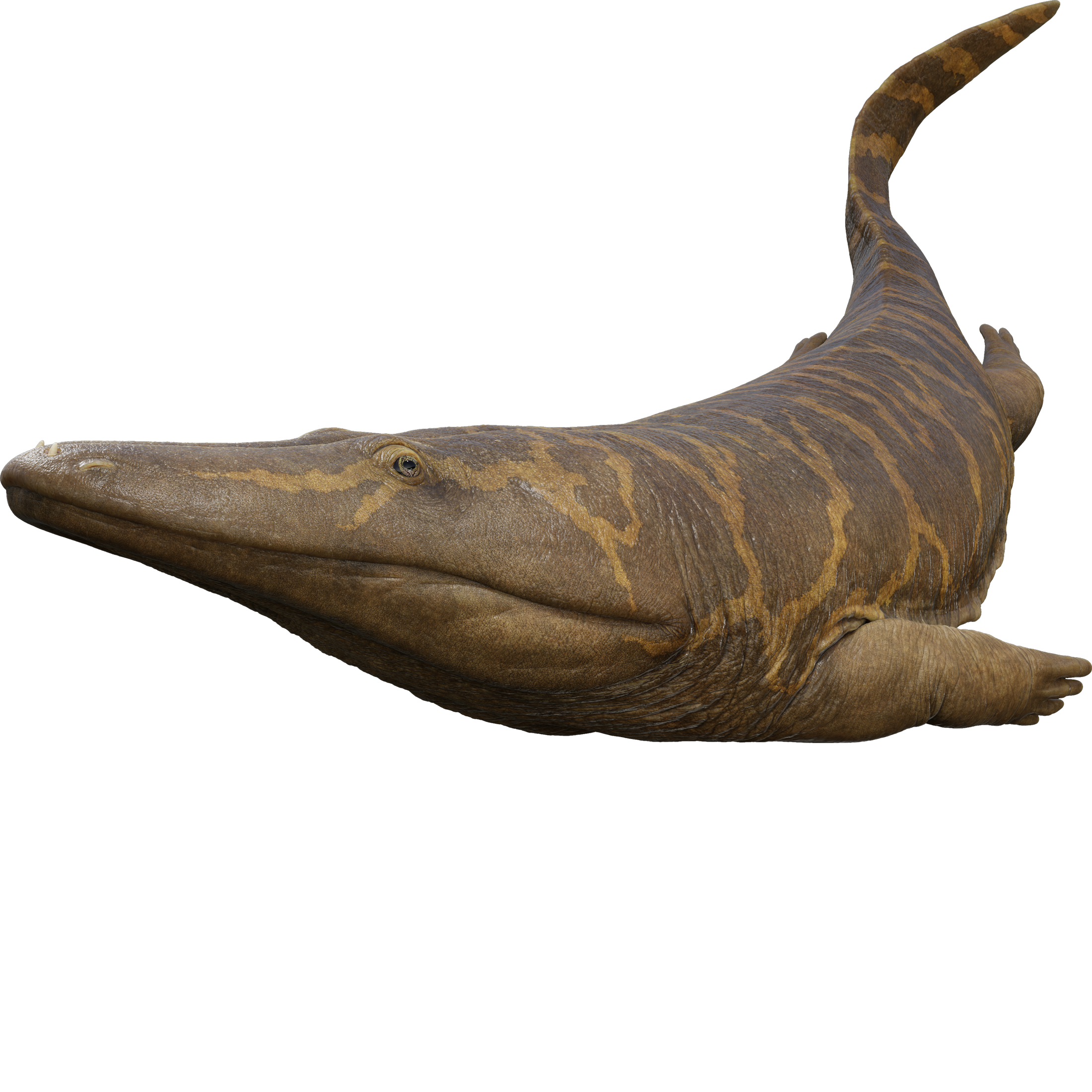Overview: Discovered in Germany in 1828, the giant Triassic temnospondyl amphibian Mastodonsaurus is still one of the largest known amphibians ever discovered, possibly THE largest. It was a mostly aquatic apex predator bigger than a modern crocodile, equipped with jaws over a meter long and fearsome teeth. It had little to fear except its own kind, as well as the giant terrestrial archosaurian predators that ruled the land. Mastodonsaurus reigned over the end of a golden age of amphibian predators in the middle Triassic, but its extinction would signal the beginning of the end for these strange giants, as temnospondyl amphibians gradually began to lose ground to semi-aquatic reptiles such as the phytosaurs, and later, crocodyliforms.
Discovery: Mastodonsaurus is known from multiple specimens found in the middle Triassic rocks of the Efurt Formation of Germany, mostly in the German state of Baden-Württemberg. The original remains consisted of a single large tooth, which was named in 1828 by German paleontologist Georg Friedrich von Jaeger. Mastodonsaurus means “teat-toothed lizard”, named because of the shape of the tooth and because at the Jaeger thought it belonged to reptile. The same year, he discovered from the same rocks, the back of a skull which he recognized as an amphibian which he named Salamandroides giganteus. This was later found to be Mastodonsaurus and became Mastodonsaurus giganteus. English Paleontologist Richard Owen disliked the name Mastodonsaurus, fearing it would be confusing due to “mastodon” being the common name for a type of extinct proboscidean (elephant-relative) and because “saurus” implied that Mastodonsaurus was a reptile, despite it being an amphibian. Thus, he attempted to rename it Labyrinthodon, but due to the rules of zoological nomenclature requiring the original name to be used, Mastodonsaurus remains the recognized name. There are three recognized species of Mastodonsaurus, M. giganteus (the best-known species), M. jaegeri, and M. torvus. M. torvus hails from Russia, while the other two hail from Germany, and may actually be the same species, in which case, there are only two species, M. giganteus and M. torvus.
Evolution: Mastodonsaurus was a type of temnospondyl. Temnospondyls were a clade of large amphibians with unclear relation to extant amphibians which they differed from in several ways including their much larger size and their thick scaley skin which differed from the thin naked skin of extant amphibians. Temnospondyls existed as far back as the Carboniferous Period but hit their heyday in the Early Triassic. Mastodonsaurus belonged to a subgroup of temnospondyls called Stereospondyli, which were more aquatic and less amphibious, having weak limbs which would have limited their locomotive efficiency on land, restricting them to a strictly aquatic habitat.
Description: Mastodonsaurus outwardly looked like a huge bulky salamander, probably with a fleshy lobe on its tail to aid in propelling it through the water. However, unlike salamanders and other modern amphibians, the skin of Mastodonsaurus would have more resembled that of a crocodile. It was also much, MUCH bigger than any modern amphibian. At 4-6 meters (13-20 ft) in length and weighing somewhere in the ballpark of 2,000 kg (4,409 lbs), it was larger than the biggest crocodiles of today, and it may have been the largest amphibian ever discovered. The Permian temnospondyl Prionosuchus is often said to be the biggest amphibian, with some online sources declaring it as much as 9 meters (30 ft) in length. However, these estimates, though oft repeated, don’t appear in any published peer reviewed literature and may be dubious, if not fictitious. The largest Prionosuchus size estimate in published literature is 5.5 m, slightly smaller than Mastodonsaurus. Thus, unless a verifiable source is found supporting a 9 m length estimate for Prionosuchus, it is Mastodonsaurus which wears the crown. The skull of Mastodonsaurus is triangular and about 1.5 meters (4.9 ft) long and its jaws were lined with sharp conical teeth. Additionally, it had a pair of large tusk-like fangs at the front of the lower jaw. These protruded through the upper jaw right in front of the nostrils when its mouth was closed.
Like modern amphibians and many reptiles, Mastodonsaurus was cold-blooded and possessed a sort of third “eye”, called a parietal eye, on the roof of the skull. This “eye” was linked to its pineal gland and helped it regulate its circadian rhythm and hormones. Also like modern amphibians, despite its thicker skin, Mastodonsaurus still laid its shell-less eggs in water. It is unclear if they were born as tadpoles, however, and if they were, they seem to have reached their adult form early, with juveniles resembling smaller versions of the adults. It has been suggested that these amphibians lacked a true larval stage altogether. Grooves and pits on the skull reflect the presence of special sensory organs which helped Mastodonsaurus detect vibrations and changes in pressure underwater, a sort of “sixth sense” used in hunting aquatic prey – or in avoiding becoming prey, similar to the lateral lines of many fish.
Behavior and Ecology: Mastodonsaurus was the apex aquatic predator in its environment, and probably had a similar lifestyle to modern crocodiles, except they likely almost never left the water. It probably ate about whatever would fit in its mouth, and it may have used suction feeding when hunting underwater, opening its mouth and flexing its throat, creating a vacuum which would suck its prey toward its fearsome jaws. It likely hunted terrestrial prey as well, ambushing them at the water’s edge like a crocodile. Its front fangs would have been useful for piercing and holding large prey. Its own kind apparently were not off the menu as bite marks indicate that Mastodonsaurus ate smaller temnospondyls, even including juvenile Mastodonsaurus. Nevertheless, based on coprolites, it seems that its most frequent prey was fish.
Mastodonsaurus inhabited freshwater and brackish swamps, lakes, and river deltas, and may have occasionally ventured out to sea for short stints. In the water, no creature was its match. But where land and water met, Mastodonsaurus did have one predator. The large archosaur Batrachotomus, a close relative of the South American Saurosuchus. Mastodonsaurus is thought to have preyed upon juvenile Batrachotomus, but the giant reptile apparently returned the favor as bite marks show that Batrachotomus at least somewhat regularly hunted the giant amphibians, perhaps venturing into the shallow water or by preying upon Mastodonsaurus trapped in shrinking seasonal pools.
Extinction and Legacy: The exact causes for the extinction of Mastodonsaurus are unknown. Mastodonsaurus lived at the end of the Middle Triassic Period and while there is no recognized mass extinction event which separates the Middle and Early Triassic, many faunal changes were nevertheless occurring, one being a gradual decline in temnospondyl amphibians, largely in response to competition from semiaquatic reptiles such as the phytosaurs. The Early Triassic saw the peak of Temnospondyl diversity, and temnospondyl size peaked in the Middle Triassic with Mastodonsaurus, but afterward, they began a slow decline throughout the rest of the Triassic, took a major hit during the Triassic-Jurassic Extinction event, and continued to dwindle until they eventually went extinct worldwide in the early Cretaceous. The disappearance of Mastodonsaurus was the beginning of the end for these monster amphibians, signaling a shift from amphibian dominated wetlands to wetlands dominated by reptilian predators. Today Mastodonsaurus can be seen in museums such as the Muschelkalkmuseum in Ingelfingen, Baden-Württemberg, Germany, the Naturmuseum Senckenberg in Frankfurt, Hesse, Germany, the State Museum of Natural History Stuttgart in Stuttgart, Baden-Württemberg, Germany, and the American Museum of Natural History in New York City, New York, USA.
Mastodonsaurus FAQ
Mastodonsaurus size / How big was Mastodonsaurus?
See weight and length.
Mastodonsaurus weight / How much did Mastodonsaurus weigh?
Mastodonsaurus probably weighed around 2,000 kg (4,409 lbs), possibly the largest amphibian ever!
How long was Mastodonsaurus?
Mastodonsauruswas about 4-6 meters (13-20 ft) long, similar to the largest of today’s crocodiles!
What was the biggest amphibian ever?
Mastodonsaurus was one of the largest amphibians of all time, if not the largest. Sometimes Prionosuchus is put forward as the largest, however, this cannot be verified by official scientific sources, therefore based on verifiable data, Mastodonsaurus may be the true record holder.
What did Mastodonsaurus eat?
Like many modern amphibians, Mastodonsaurus probably ate about any animal it could fit in its mouth. This likely included fish as well as land animals such as juveniles of the rauisuchian Batrachotomus.
What is Mastodonsaurus’s closest living relative?
The closest living relative of Mastodonsaurus are modern amphibians, though Mastodonsaurus was on a separate branch of the amphibian family tree so even modern amphibians are only very distantly related.
Mastodonsaurus family members / Mastodonsaurus family / What kind of animal was Mastodonsaurus?
Mastodonsaurus was in the family Mastodonsauridae, in the clade Capitosauria, and the clade Stereospondyli, which belonged to a large group of amphibians called Temnospndyli which were highly diverse and successful during the Carboniferous-Triassic periods, before declining starting in the Late Triassic and going extinct in the Early Cretaceous. Their evolutionary relationship to other amphibians is uncertain.
Where did Mastodonsaurus live? / Where was Mastodonsaurus found?
Mastodonsaurus lived in freshwater and brackish swamps, lakes, and river deltas in what is now Germany.
When did Mastodonsaurus live?
Mastodonsaurus lived about 242-237 million years ago during the Middle Triassic Period.
What does Mastodonsaurus mean? / Mastodonsaurus name meaning
Mastodonsaurus means “teat-toothed lizard”, named for the shape of its teeth.

